If your child wants to learn about the bones in their body, you can easily teach them by using a built-in teaching aid - their own skeleton.
Or, you can peruse Science With Me!’s own resident skeleton, Stanley, for a look at the way bones are organized in the human body!
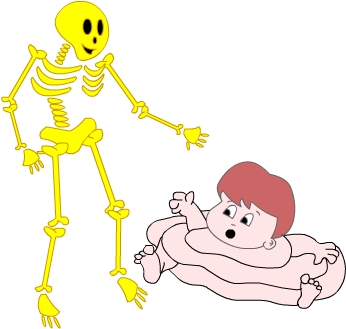 The human skeleton, and the bones that comprise it, has one undeniably important function - it keeps us standing. Without this framework, none of our other systems would stay in a set location, or be able to function properly. In fact without our skeleton we would just be a big, gelatinous mass lumped on the floor! When you are teaching your child about the bones in their body, you can use your sense of touch to find most of them through their skin. First of all, there are 206 bones in the human body. (Don’t worry, you don’t have to know all of their names- just the prominent ones that you want your child to know!) Our bones can be classified into 4 groups. (Whew…that’s easier.) They can be long bones, like the bones in our legs and arms; short bones, like those in our fingers; flat bones those that make up our skull; and irregular bones, like the bones that are found in our spinal column.
The human skeleton, and the bones that comprise it, has one undeniably important function - it keeps us standing. Without this framework, none of our other systems would stay in a set location, or be able to function properly. In fact without our skeleton we would just be a big, gelatinous mass lumped on the floor! When you are teaching your child about the bones in their body, you can use your sense of touch to find most of them through their skin. First of all, there are 206 bones in the human body. (Don’t worry, you don’t have to know all of their names- just the prominent ones that you want your child to know!) Our bones can be classified into 4 groups. (Whew…that’s easier.) They can be long bones, like the bones in our legs and arms; short bones, like those in our fingers; flat bones those that make up our skull; and irregular bones, like the bones that are found in our spinal column.
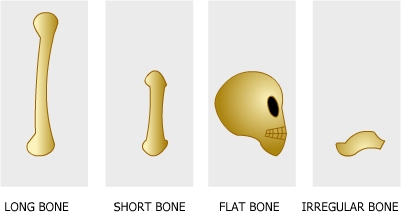 Engage your child in a tapping session, on his/her body, to find and identify at least one of each type of bone.
Engage your child in a tapping session, on his/her body, to find and identify at least one of each type of bone.
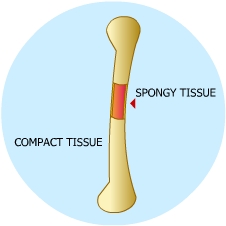 Bones are made up of 2 types of tissue. The first is called compact tissue and is what we all know as the hard surface on the outside of the bone.The second is called spongy tissue which is the inner part of the bone. (Your child will not be able to touch this layer of the bone - unless she becomes a surgeon.) Our bones are classified in one of two groups depending on which part of the skeleton they are found in. The axial skeleton is made up of the skull - give it a tap; the vertebral column, which runs down our back; the ribs - we all know where these are; and the sternum, which is otherwise known as our breast-bone. This portion of the skeleton acts as the major support system to keep your body standing upright.
Bones are made up of 2 types of tissue. The first is called compact tissue and is what we all know as the hard surface on the outside of the bone.The second is called spongy tissue which is the inner part of the bone. (Your child will not be able to touch this layer of the bone - unless she becomes a surgeon.) Our bones are classified in one of two groups depending on which part of the skeleton they are found in. The axial skeleton is made up of the skull - give it a tap; the vertebral column, which runs down our back; the ribs - we all know where these are; and the sternum, which is otherwise known as our breast-bone. This portion of the skeleton acts as the major support system to keep your body standing upright.
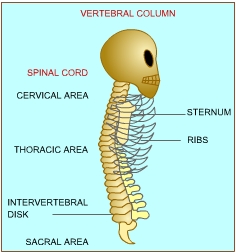 The appendicular skeleton- a bit of a mouthful, even for an older child; consists of the bones of all four limbs and the girdles - not the Lycra type - in the pelvic and shoulder area. This part of our skeleton contains all of the bones whose names we are quite familiar with. In our arms, our funny bone, or humerus, is found coming from our shoulder bone and continuing to our elbow. This is the bone that brings anything BUT a chuckle if we slam it- or more accurately, the nerve that runs along it. The radius and ulna are the two bones that run from the elbow to our wrist and are the arm bones most commonly broken and seen in plaster casts! We have many small bones in our hands and they end up at the finger bones which are known as phalanges. Try an old song with your kids to help them remember how the bones of the legs are organized; the hip bone’s connected to the thigh bone - or substitute it’s real name, femur. The femur’s connected to the shin bones - tibia and fibula . - The tib and fib are connected to the ankle bone ( talus) . The talus is connected to the heel bone ( calcaneum). The calcaneum’s connected to the foot bones. And the toe bones are at the end… phalanges! Alternatively if singin is not your thing.
The appendicular skeleton- a bit of a mouthful, even for an older child; consists of the bones of all four limbs and the girdles - not the Lycra type - in the pelvic and shoulder area. This part of our skeleton contains all of the bones whose names we are quite familiar with. In our arms, our funny bone, or humerus, is found coming from our shoulder bone and continuing to our elbow. This is the bone that brings anything BUT a chuckle if we slam it- or more accurately, the nerve that runs along it. The radius and ulna are the two bones that run from the elbow to our wrist and are the arm bones most commonly broken and seen in plaster casts! We have many small bones in our hands and they end up at the finger bones which are known as phalanges. Try an old song with your kids to help them remember how the bones of the legs are organized; the hip bone’s connected to the thigh bone - or substitute it’s real name, femur. The femur’s connected to the shin bones - tibia and fibula . - The tib and fib are connected to the ankle bone ( talus) . The talus is connected to the heel bone ( calcaneum). The calcaneum’s connected to the foot bones. And the toe bones are at the end… phalanges! Alternatively if singin is not your thing.
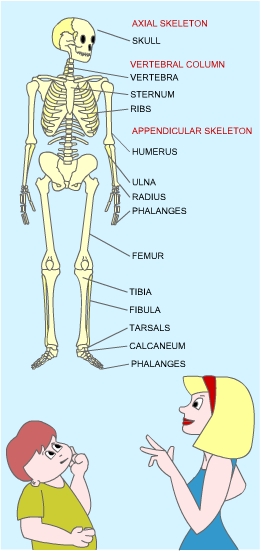 The vertebral column , or backbone, is the major force which supports us in standing upright. Its shape is a double ‘S' and its structure is much like a tunnel of bone through which the spinal cord runs. The spinal cord is very delicate but is well protected by the bone structure of the vertebral column. The bones of the vertebral column - there are 24 of them - all have interesting shapes that can be felt by running a finger down someone’s back. (Your child probably cannot feel his own vertebral column , so he may have to borrow yours') The spine is divided into 4 sections; the cervical area at the neck ;the thoracic area to which the rib cage is attached;he lumbar area just beneath the thoracic area and the sacral area which ends in your tail-bone. Between each bone in the vertebral column is an intervertebral disk - or simply disk. These disks are soft and spongy and allow some flexibility to the spine so that we can use our backs for many movements. In fact, all bones are joined together in some sort of fashion which permits movement. The places where bones meet are called joints. The knees and the elbows are examples of joints and are very easily demonstrated to your child by having them bend and straighten their arms or their legs. Skeletons can be very intriguing to a child. They have been portrayed as creepy and scary. However, by simply using their own bodies, you can help your children to understand that bones, and the skeleton, form an important part of everybody’s anatomy. They are the support structure that keeps us upright and walking tall! So why not teach your child to stand up straight and to make no bones about learning the story of the skeleton that lurks within us all! Want to learn more about the Human Skeleton? Check out the free previews from our Stanley the Skeleton Activity Set! You can also download some skeleton worksheets to practice naming all the different bones.
The vertebral column , or backbone, is the major force which supports us in standing upright. Its shape is a double ‘S' and its structure is much like a tunnel of bone through which the spinal cord runs. The spinal cord is very delicate but is well protected by the bone structure of the vertebral column. The bones of the vertebral column - there are 24 of them - all have interesting shapes that can be felt by running a finger down someone’s back. (Your child probably cannot feel his own vertebral column , so he may have to borrow yours') The spine is divided into 4 sections; the cervical area at the neck ;the thoracic area to which the rib cage is attached;he lumbar area just beneath the thoracic area and the sacral area which ends in your tail-bone. Between each bone in the vertebral column is an intervertebral disk - or simply disk. These disks are soft and spongy and allow some flexibility to the spine so that we can use our backs for many movements. In fact, all bones are joined together in some sort of fashion which permits movement. The places where bones meet are called joints. The knees and the elbows are examples of joints and are very easily demonstrated to your child by having them bend and straighten their arms or their legs. Skeletons can be very intriguing to a child. They have been portrayed as creepy and scary. However, by simply using their own bodies, you can help your children to understand that bones, and the skeleton, form an important part of everybody’s anatomy. They are the support structure that keeps us upright and walking tall! So why not teach your child to stand up straight and to make no bones about learning the story of the skeleton that lurks within us all! Want to learn more about the Human Skeleton? Check out the free previews from our Stanley the Skeleton Activity Set! You can also download some skeleton worksheets to practice naming all the different bones.
